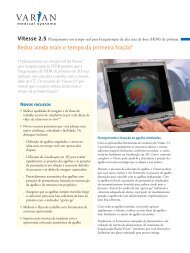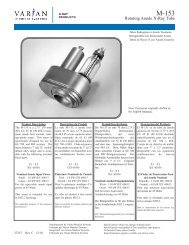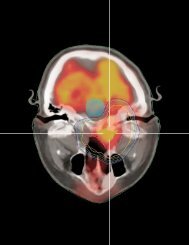Varian Linatron High-Energy X-ray Applications 2007
Varian Linatron High-Energy X-ray Applications 2007
Varian Linatron High-Energy X-ray Applications 2007
You also want an ePaper? Increase the reach of your titles
YUMPU automatically turns print PDFs into web optimized ePapers that Google loves.
Table 4-3 lists some relative speeds for the various types of<br />
fluorescent screens currently available. Fluorescent screens<br />
must be well maintained, carefully handled, and kept<br />
clean. Dust particles leave white spots as images on the<br />
film and screens deteriorate with age.<br />
X-Ray Film Characteristics<br />
Film Properties and Classification. Commercial X-<strong>ray</strong><br />
films that have been used for years in kilovoltage and<br />
megavoltage X-<strong>ray</strong> and gamma-<strong>ray</strong> radiography also meet<br />
the needs of high-energy <strong>Linatron</strong> radiography.<br />
Speed. The relative speed of commercial X-<strong>ray</strong> film can be<br />
established with the <strong>Linatron</strong> by exposing each film in a<br />
real radiography arrangement until it will produce a<br />
developed film darkening of a specified density.<br />
<strong>Energy</strong> (MeV)<br />
1-4<br />
6-9<br />
15<br />
Radiographic Conditions<br />
Flat object, low scatter, up<br />
to 4 inches steel or equal.<br />
Complex object, high<br />
scatter, or thick object<br />
over 4 in. of steel or equal.<br />
Flat object, low scatter, up<br />
to 5 inches steel or equal.<br />
Complex object, high<br />
scatter, or thick object<br />
over 5 in. of steel or equal.<br />
Flat objects, low scatter,<br />
up to 6 inches steel or<br />
equal.<br />
Complex object, high<br />
scatter, or thick object<br />
over 6 in. steel.<br />
Table 4-2 Suggested Screen and Filter Thickness Speed<br />
page 18<br />
Example<br />
A comparison chart can be created for various film types<br />
by exposing each film to produce a specified density, such<br />
as 2.0 on the H. & D. scale. If all other variables are held<br />
constant, a relative film speed index can be assigned to<br />
each film, with a numerical value that is proportional to<br />
the exposure level needed to obtain the 2.0 film density<br />
The data presented in Table 4-3 was obtained using this<br />
procedure.<br />
A change in screen material or thickness will cause<br />
shorter or longer exposures. Therefore, the film speed<br />
index will depend on the specific screen used. The<br />
specific developing technique can change the film speed<br />
index by up to 100%. Therefore, it is as important to<br />
quantify and control the developing process as carefully<br />
as the exposure itself.<br />
Screen Thickness<br />
Front Back<br />
0.010 in 0.010 in<br />
(0.25 mm) (0.25 mm)<br />
0.020 in 0.010 in<br />
(0.51 mm) (0.25 mm)<br />
0.020 in 0.010 in<br />
(0.51 mm) (0.25 mm)<br />
0.030 in 0.010 in<br />
(0.76 mm) (0.25 mm)<br />
0.030 in 0.010 in<br />
(0.76 mm) (0.25 mm)<br />
0.050 in 0.010 in<br />
(1.27 mm) (0.25 mm)<br />
* Back lead filters may be placed behind the film holder if there is a large amount of backscatter present. 0.250-inch (6.35 mm) thickness<br />
should be adequate for all cases.<br />
** Object filters are placed between the object and the film holder to reduce the effect of secondary or scatter radiation, or scatter generated by<br />
the object.<br />
<strong>Varian</strong> <strong>Linatron</strong> applications<br />
Remarks<br />
Backing lead as needed.*<br />
0.030 in. lead or composite<br />
object filter may improve<br />
sensitivity.**<br />
Backing lead as needed.*<br />
0.030 in. lead or composite<br />
object filter may improve<br />
sensitivity.**<br />
Backing lead as needed.*<br />
0.125 in. lead or composite<br />
filter may improve<br />
sensitivity.**


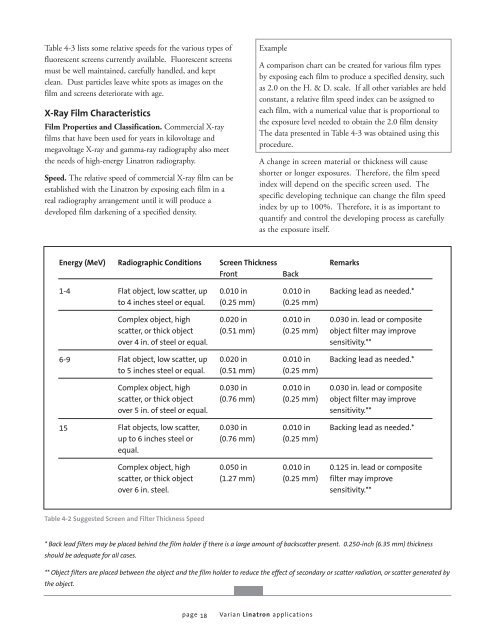






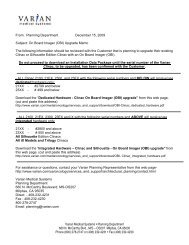
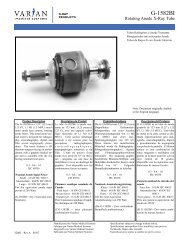
![[MSDS 126] Dow Corning 200 Fluid, 5 CST Part Number ... - Varian](https://img.yumpu.com/5104917/1/190x245/msds-126-dow-corning-200-fluid-5-cst-part-number-varian.jpg?quality=85)


